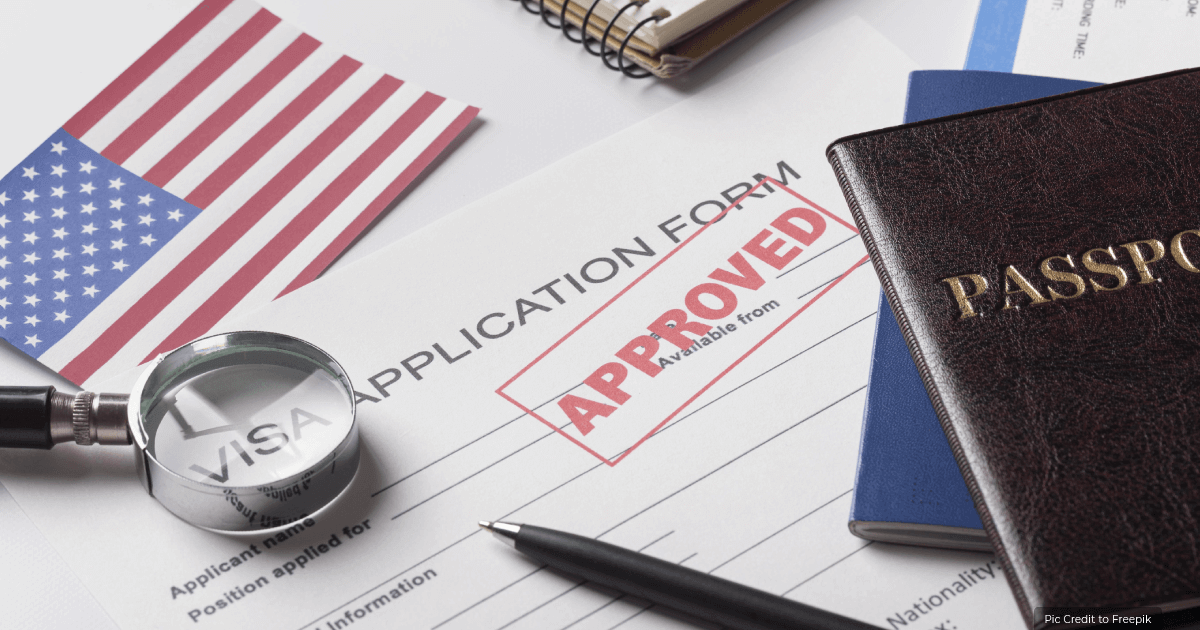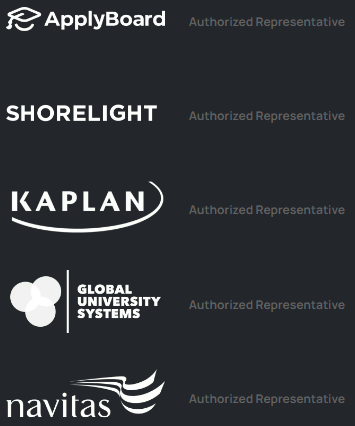Process for US Student Visa in 2026 – Once you have qualified and received your admission letter, you are just one step away from getting to your dream college. This one step is to get your US Student Visa application approved. Over ten thousand students reach the US for further education every year. The US has become a country which has to offer opportunities with its well-known educational hubs. More than nearly 1 million students are drawn to the idea of studying advanced degree courses in the US, according to the Institute of International Education.
Nevertheless, there are so many opportunities after completing your degree in the US. If you want to secure your US study visa in 2026, and if you are a beginner, then the documentation and paperwork become so daunting at first. However, once you understand the whole procedure and break it down into small steps, you can easily get your US Student Visa 2026. Here in this blog post, we are going to explain the step-by-step process for US Student Visa, the types of US Student Visa, and how to apply while you begin your course.

Types of Student Visas in the US 2026
There are three types of US Visa for international students who want to study in the US, that are F, M, and J.
F Visa
- The F Visa is for students who want to pursue an academic degree at a higher accredited university or plan to study English on a full-time basis.
- The first type of F Visa is the US F1 Visa in which holders are allowed to work for 20 hours or less on the campus as per the University rules.
- The second type is the F2 Visa, which is given to the dependents of an F1 visa. Considerably given to spouses or unmarried children under of age 21 years.
- The third type is the F3 Visa, which is called “border commuters”.
This Visa is given to the students who belong to Mexico and Canada living in the US for their studies at US University as a part-time or full-time student. The basic requirements to apply for Visa are –
- English Language Proficiency Test (IELTS/TOEFL)
- Funds to finance your studies
- Passport validity after six after you graduate for US travel
M Visa
- The M Visa is for students who want to pursue non-academic or vocational degrees or training.
- Therefore, the US M1 Visa is only for a fixed period of time and as per the duration of the course at the US University.
- The M1 Visa holders are not allowed to stay in the US for more than a year and are also not allowed to work on or off campus.
- Similar to the US F2 Visa, the M2 Visa is given to the dependents of the M1 Visa. Further, M3 Visa is given to “border commuters”.
J Visa
- For individuals participating in U.S. exchange programs – students, interns, researchers, teachers, au pairs, etc.
- Requires a U.S. State Department-approved sponsor to issue a Form DS-2019.
- Varies by program (from a few weeks to several years), with potential for a grace period of 30 days after completion.
- Some J-1 holders must return to their home country for 2 years before applying for certain U.S. visas.
- Spouses and children can apply for a J-2 visa, which may allow work/study with appropriate authorization.
Process for US Student Visa in 2026
Now, let us dive deep into the US student visa process for 2026
Step 1: Choose a College and Program
The first and foremost step is to choose a college and program. You must consider looking at your academics and personal interests; for instance, if you are willing to study marketing, then you must consider looking top level university for marketing. Then, comes the admission requirements, which varies depending on various terms and conditions of the universities. The basic requirements are English proficiency test, recommendation letter from your professor, Statement of Purpose (SOP), etc.
Once you have everything set, you might have to pay an application fee to take your application to the next step. After the submission of the application, you may have to wait for some time to receive your admission confirmation. Next, when you receive your admission confirmation from the respective University, you are good to go to apply for a US Student Visa.
Acceptance and Get I-20
The F-1 student visa process commences upon acceptance to a US university that is SEVP-certified. SEVP certification is the US government’s method of verifying that your university is accredited and has the necessary resources to offer you an education. You will receive your I-20 form from your university upon acceptance. This form serves as a record of your academic objectives and offers pertinent details regarding your visit. When your I-20 is issued, the Student and Exchange Visitor Information System (SEVIS) records the subsequent information –
- Your SEVIS ID number
- Start and Finishing dates of your program
- Your intended course of study
- The sources of your funding
- Cost of attending the institution of your choice
- Additional personal information
This information is provided by your university in accordance with the materials you submit as part of your application. Upon receiving your I-20, verify that all of the information is accurate and subsequently sign the bottom of the first page immediately. The process of rectifying an error on your I-20 can be lengthy, and if an error is present, you may not be permitted entry into the country. When traveling to the United States, ensure that you retain your I-20 form. It will be necessary for you to enter the United States, work, and engage in other activities, such as obtaining a US driver’s license.
Step 2: Pay the SEVIS Fee
Once you have received your offer letter from the university, you are ready to get Form I-20. SELVIS stands for Student and Exchange Visitor Information System. To get this form, you have to pay a SELVIS-I 901 Fee. The Visa officer needs an I-20 form during the US F1 Student Visa Interview. In some cases, if you are planning to take your spouse or family member with you and they are going to reside with you, then you have to get an I-20 Visa form individually for them. For them, their forms need not go through the SELVIS enrollment process because they would be travelling as dependents and would not study at your institution. The entire cost of your F-1 student visa, which encompasses the visa itself, SEVIS processing and maintenance fees, will be approximately $535.
Requirements – Your I-20
The cost is $350.
Where to submit your application – SEVIS fee payment portal?
Make certain to retain the receipt for the I-901 SEVIS fee. It will be necessary for your visa interview.
SELVIS Fee is a centralized computer system that stores the data related to international students, student exchange, and their dependents as per the course duration. SELVIS monitors the Student and Exchange Visitor Program.
What is the SEVIS fee?
The SELVIS Fee is a one-time fee that is compulsory for students applying for F-1/J-1 status. This fee is the operating cost and is excluded from other fees. You must pay the fees at least three working days before your Visa interview at the US Consulate or Embassy. Once you have paid the SELVIS fee, you must take out the printout and have it handy while going for your visa interview.
How to Pay the SEVIS fee?
1. Firstly, complete your Form I-901
- J-1 Students must use the program number of the university
- F-1 Students must use the College or University Code
2. Use one of the two payment methods to pay
Importance of the SEVIS Fee Payment
The SELVIS fee payment is important for your application process because the computerized systems store and monitor students’ data. This will help students allocate seats to the specific program and keep all documents in one place. Therefore, SELVIS fee payment becomes an obligation while you are applying for program enrollment in the US. Also, it will help you get a US student visa.
How Much is the SEVIS Fees for US Student Visa
| Description | Amount |
|---|---|
| I-901 SEVIS Fee F or M visa applicants (full payment) | $350 |
| I-901 SEVIS Fee J visa applicants (full payment) | $220 |
| I-901 SEVIS Fee special J-visa categories (subsidized payment) | $35 |
| I-901 SEVIS Fee government visitor (no payment) | $0 |
Step 3: Complete the Non-immigrant Visa Application
The process for F1 Student Visa varies depending on the US embassy you are dealing with. You must note that the Visa application fee is non-refundable. You have to fill out the DS-160 form and take a print of it while going for the visa interview.
Overview of the Nonimmigrant Visa Application (Form DS-160)
The DS-160 Form is an Online Nonimmigrant Visa Application form for temporary travel to the US. This form contains all the personal, professional, and educational information. Usually, the B1/B2 Visitor or K1 Visa(Fiance) holder fills out this form.
How to fill out a Non-immigrant Visa application?
To fill out the application form, you have to visit Consular Electronic Application Center and it takes around 90 minutes to complete the form. Your visa application is represented by your DS-160. In order to obtain an F-1 visa, all prospective international students are required to submit a DS-160.
Requirements – Your passport, travel itinerary, I-20, and visa photo.
The cost is $185.
Where to submit an application: Application portal for your DS-160?
Upon the successful submission of your DS-160, you will be provided with a printed confirmation that includes a barcode. Please save this form, as it will be required for your visa interview.
Step 4: Schedule Your Visa Interview Attend a Visa Interview
The first work is to visit the US Embassy site and select the country you reside and the place in US you want to study.
To appear for the visa interview, you have to schedule your interview three months before the commencement of your course. The waiting time for the schedule of the interview varies depending on the visa category, time of the year, and place applied. Thus, you must apply for your US Student Visa at the right time. Here, check out the list of documents required for applying for a US Student Visa 2026.
Note –
- If you belong to an English speaking country, you can get your Visa without IELTS and if not, you must have IELTS/TOEFL or any other English Proficiency test.
- You cannot apply for a student visa application three months before the commencement of your course.
Then, visit the US Visa Information and Appointment Services website. Below are the further steps for the website information filling.
- Select “Temporary Non-immigrant visas”.
- Select the country of the embassy or consulate you have chosen
- Click “Apply”
- Fill in your SELVIS ID and Program Number
- Pay the Visa non-refundable fee of $160 (This fee is separate from all the other scholarship fees)
- Schedule your Visa appointment
- Go for your Visa interview
Locate the closest US embassy or consulate and arrange your visa interview. Remember to schedule your appointments as early as feasible, as wait times may vary by country and can last for months.
Step 5: Attend a Visa Interview
What to Expect During the Visa Interview?
You must carry all your necessary documents with you while you go for your Visa interview. You are expected to abide by the rules and regulations.
- Reach the Consulate and stand in the Visa queue
- Go for the Security Check
- Fingerprint Verification
- Wait in the waiting area
- Interview begins
The US consulate or embassy verifies that you are a sincere, legitimate student during the interview phase of the F-1 visa application process. In addition, you must demonstrate that you have the necessary funds to support your time studying in the United States and that you intend to return home upon the conclusion of your studies during your visa interview. Although there are a few rare exceptions (e.g., if you are younger than 14 or elder than 80 years of age, or if you meet certain visa renewal requirements), it is mandatory to attend your visa interview in person..
- Expense: The expense is included in your DS-160 payment.
- Where to apply your application: The scheduling portal for your visa interview
Upon satisfactory completion of your visa interview, you will be granted an F-1 visa and will be granted F-1 status. You have been granted permission to pursue your education in the United States. In the interview, the interviewer will be behind the glass window and he will talk to you through a microphone. His voice will be audible to you as the room will have speakers.
Now the interviewer will ask you questions to verify your identity, and documents. Be confident while answering the questions, and do not show any documents if it’s not asked for. Also, try to be concise and relaxed. When the interview is over, the interviewer might say, “Visa approved”, and it will be couriered to you in 3-4 business days. And, if your Visa is on hold or does not qualify, you will be informed accordingly.
How to Prepare for the Visa Interview?
To prepare for the Visa interview, you must be truthful with your thoughts. Mainly, you have to answer the personal questions about your family, education and ambitions. You must also mention that you have willing to go abroad for your further studies and you have the intention to come back to your home country.
Practice with your family and friends and do not panic at all. The only way to get visa approval is to prepare for the interview. Ensure that you have all documents handy and you have dressed well. To be aware of what not to do, check out the common reasons for US Student Visa Rejection 2026
Step 6: Receive Your Visa and Prepare for Departure
Once you receive your Visa, you are ready to fly. The moment you get approval for your Student Visa, make sure you have enough time to look after all your arrangements and flight. The best thing would be to book your flight in advance. Carry your international debit or credit cards for financial transactions. Carry your college admission confirmation letter, Visa, etc. When you reach the destination, get your Visa stamp on your passport while you enter the country.
As per our research, the minimum time required to make the arrangement is 2 weeks. If you have done everything on time then it will help you in enjoying your orientation program.
Adjusting to Life in the United States
Now begins your new life. It is best if you would have taken a rental apartment or college hostel. Attend your classes, and meet new people across the globe, it is the time to explore your life. You can also work if your Visa approves you to do so, with that you can earn some money while living in the country.
We hope that you have understood the US Student Visa Process step by step and that you have gotten clarity. Understanding the requirements of the US Student Visa Application process is an essential step to getting your visa approval because minor mistakes could lead to disapproval of the same.
In final words, the best tips for a successful visa application process are to show your ties to the home country, be fluent in English, talk about your ambitions and give reasons for choosing the particular course. Also, the main and foremost part is to carry all the necessary documents and employment certificates. Hence, have a positive attitude towards everything you say, maintain eye contact, and dress neatly and tidily.
Admission Requirements for F-1 Visas
Ensure that the following documents are prepared for the consular officer’s evaluation prior to your visa interview –
- A valid passport
- A duplicate of the photograph that will be used to obtain your visa
- Your DS-160 and I-901 SEVIS payment confirmations in print
- I-20 form
- The legitimate test scores and school transcript that were referenced in your university application
- Diploma and other certificates (if applicable)
- Bank statements or other forms of financial documentation
- Additionally, the consular officer may request additional documentation during your interview. In order to adequately prepare, it is recommended that the following documents be brought:
- Transcripts, diplomas, degrees, or certificates from the institutions you attended are examples of academic records.
- Your US institution necessitates standardized test scores.
- Evidence of your intention to leave the United States upon the conclusion of your academic program
- Statements that demonstrate your capacity to cover all educational, lodging, and travel expenses
Interview for the F-1 Visa
You may experience feelings of uncertainty regarding your forthcoming interview as an international student. Although it is common to experience anxiety, it is important to remember to take a steady breath and trust that you are adequately prepared. While your interview is crucial, it should not be a source of anxiety.
What to Anticipate During Your Visa Interview
Your interviewer will pose inquiries to ascertain –
- Are you an authorized student?
- Are you able to finance your education?
- Do you intend to return to your hometown upon the completion of your degree?
In order to adequately prepare for your F-1 student visa interview, the following are potential inquiries –
- What was the reason for your selection of this university?
- To which other universities in the United States did you submit an application?
- What is your plan for financing your education?
- Do you have relatives in the United States?
- Are you intending to engage in employment during your stay in the United States?
- What is your intended course of action following your graduation?
Refusals of F-1 visas
Your F-1 visa application may be rejected. In the event that this occurs, you will receive a written explanation that includes the specific provision of the law that resulted in the denial of your application. In order to prevent the denial of your F-1 student visa application, it is crucial to accurately read and adhere to all instructions. Prior to submitting your application, it is imperative that you verify your documents on multiple occasions.
Please bear in mind that you must adequately demonstrate that you are traveling to the United States to pursue your education and intend to return to your home country upon the conclusion of your program during your F-1 student visa interview. As you respond to your interview inquiries, bear this in mind.
How to Maintain F-1 Visa Status?
To continue your studies in the United States as an international student, you must actively maintain your F-1 status. In order to accomplish this, you must adhere to the regulations and codes of conduct of your university, as well as the conditions and requirements outlined in your F-1 visa.
When Entering the United States –
- Ensure that you enter the United States no later than 30 days prior to the commencement of your program.
- Contact your designated school official (DSO) immediately upon your arrival in the country.
- Contact your DSO once more prior to the commencement date specified on your I-20 form upon your arrival at your university.
While Pursuing a Degree in the United States –
Maintain a high academic standing by attending all of your courses.
If you require additional time to complete your program, which would exceed the end date specified in your I-20, consult with your DSO to explore potential extensions.
- Ensure that you enroll in a comprehensive course of study during the academic term.
- Please consult with your DSO prior to withdrawing from or changing classes.
In order to take a sabbatical and/or go on vacation, it is important to ensure that you have completed at least one full academic year at your institution. Additionally, you are required to enroll in courses for the subsequent academic term following your vacation.
Is it possible for F-1 international students to work in the United States?
Certainly, you will be permitted to labor in the United States while holding an F-1 student visa. Nevertheless, you will be required to adhere to specific regulations and restrictions regarding the F-1 visa –
- While your academic term is in session, you are permitted to labor on campus only part-time.
- A maximum of 20 hours of labor per week is permissible.
- Your university may authorize your employment outside of the campus.
If your university permits it, you will be permitted to work full-time during academic intervals. For additional information regarding employment as an F-1 international student, please consult USCIS.gov. Ensure that you obtain sanction from your DSO prior to conducting job searches while you are pursuing your education. Please be advised that you will have a 60-day grace period to depart the United States after completing your program.
After gaining an understanding of the process of US non-immigrant visas for international students, it is recommended that you develop a checklist of the subsequent steps and commence the process. The sooner you commence the process of meeting the study visa requirements for the United States, the greater your likelihood of obtaining a place at an American university.
What if you still don’t have clarity?
Worry not! We are here at your rescue. We can help you fill out your visa application form and smooth the process of submitting a US student visa application. Fill out the form below, and we assure you that our admission managers at SecureMyScholarship can ease your US Student Visa process.





